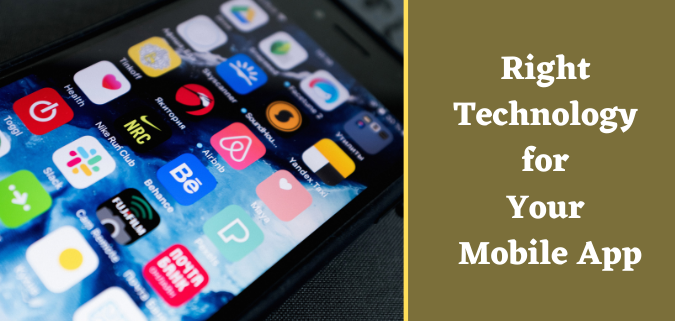Are you planning to build an app? Willing to ease your website traffic? Well, creating an app is not an easy job. One needs to figure out what technology stack to use, which is best and why, how to select from the list, so on and so forth.
Before we begin to get into the nitty-gritty of developing an app, we need to decide upon which software to use. A Technology stack helps in developing that; it is divided into four sections:
- Front-end Development – The screen of which the user is going to communicate with the app.
- Back-end Development – The part in which responses are shared after certain user actions on the mobile app.
- Development Platform – The plan to design and build up a mobile application by using specific interfaces and libraries
- Additional – The security, performance, effectiveness, an
d all the other details for the smooth functioning of the app
This area is vital to affect the best performance of your app. The right choices
of the software will help the app to work in the desired Operating System smoothly. Any irrational decision might adver
surely affect the functioning of the mobile app and its prospects.
Now, as you have understood the base of developing the app, let’s move on to the section where we have to decide the right type of mobile app based on the technology stack. The right choice will yield valuable results for the company/individual and vice versa.

- Native App Technology Stack – This type of technology is used for specific mobile phones OS. For example, specific technology for Android OS and similarly for iOS apps. Since they are developed for one platform, you cannot blend and mix.
- Technology/Coding Programmes used – Java, Kotlin, Python, Swift, Objective-C, C++, and React.
- Web App Technology Stack – These applications are similar to native apps but are accessed only via an internet browser on your mobile phones. They are dependent applications, unlike native apps, which can be downloaded directly from specific app stores. An example of such an app within a browser is the Progressive Web Application (PWA).
- The technology used – HTML5, CSS, JavaScript, Ruby, and similar programming languages.
- Hybrid App Technology Stack – Then comes these kinds of applications, where these are web apps made to resemble native apps closely. Home icon features with quick responses and offline facility are some of its pros.
- Technology used – A mixture of web technologies and native APIs. They’re developed using: Ionic, Objective C, Swift, HTML5, and others.
Considering all the above information, you may still want to ask about which technology is right and why?
This depends on several factors, ranging from application goals to its security or compatibility. This is a very deliberated process since its outcome is the end result that users would be using. Let us now study these factors which influence the right choice.
Type of Application
Various factors are varying from one app to the next; that could be
- The device on which you’d like to use the app.
- The targeted market.
- The network condition it would run in.
- The user satisfaction while using the app.
- The platform on which it would run.
All these variables determine or help decide to choose between the right software, coding, languages, library, and the overall structure of the mobile app and the device on which it’ll run upon.
Application Goals
What is the organization’s aim when it decides to develop an app? What should the app be able to fulfill? A quick responsive app vs. a heavy, robust feature-laden app? A high latency app vs. a simple user interface feature app? If performance is your aim, then you would probably look to build a native app.
Functionality and Compatibility
Existing technology is the prime factor that we look for when developing an app. Specifically when you are trying to bring in a new form of tech stack after the mobile app. Apart from this, we also need to run the compatibility test to know whether the tools used (or to be used in the future) are running smoothly or not.
Portability to Run Across Platforms
The tech stack used to create an app, keeping in mind one platform, will be quite different from the one that can run on either of the three discussed –Android, iOS, and Web. It would help if you had specific toolsets to create an app portable enough across different platforms, unlike the toolsets used for one platform.
Industry-Specific Requirements
Few companies offer better documentation and community support. Google, Adobe, Microsoft have all pioneered in their fields and offer brilliant opportunities. Creating an app using a tech stack in which your team/organization is acquainted will help you yield positive results. It is cost-effective with top-level work.
Security
Every app built is enhanced by tackling security threats through cyber attacks. However, issues can come when proper documentation has not been conducted for the app. Later also comes the individual’s skill, hacking is now common practice, but it is the developer’s skill, which can cause troubles for these hackers.
Conclusion
Since now you have some idea of what it takes to create an app, it’s probably right to mention an individual’s skill and experience. The mobile app developer needs to be well versed with all the technology, with the client’s requirements, and specifically with his needs to create one. It would be best if you chose the suitable options to allow the app to function well. Being aware of the needs of the end-user is equally essential to use the right tools. Eventually, picking which kind of mobile application you will assemble is certifiably not a one-and-done choice. You can generally decide to fabricate another sort as it were, depending upon your client’s necessities. When you do at long last form it, ensure you screen the measurements that matter for the genuine development of your brand image.

